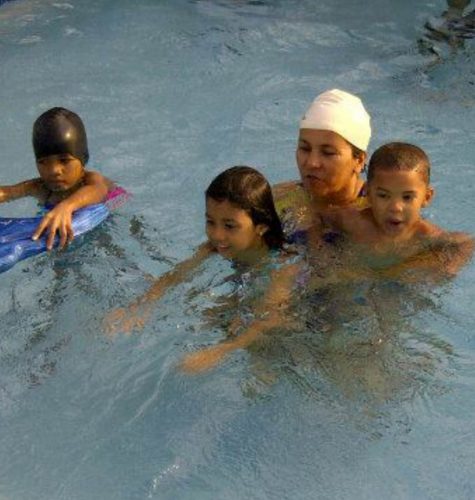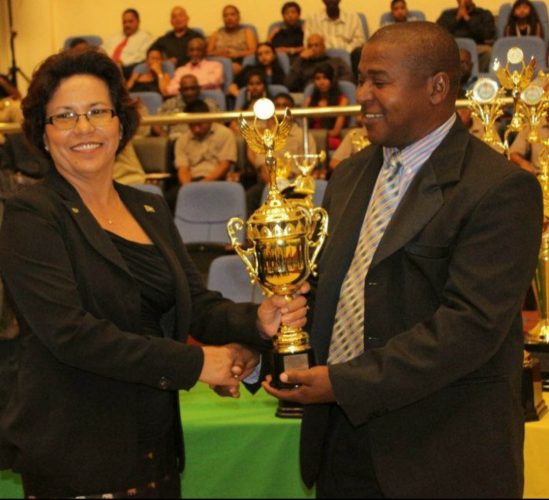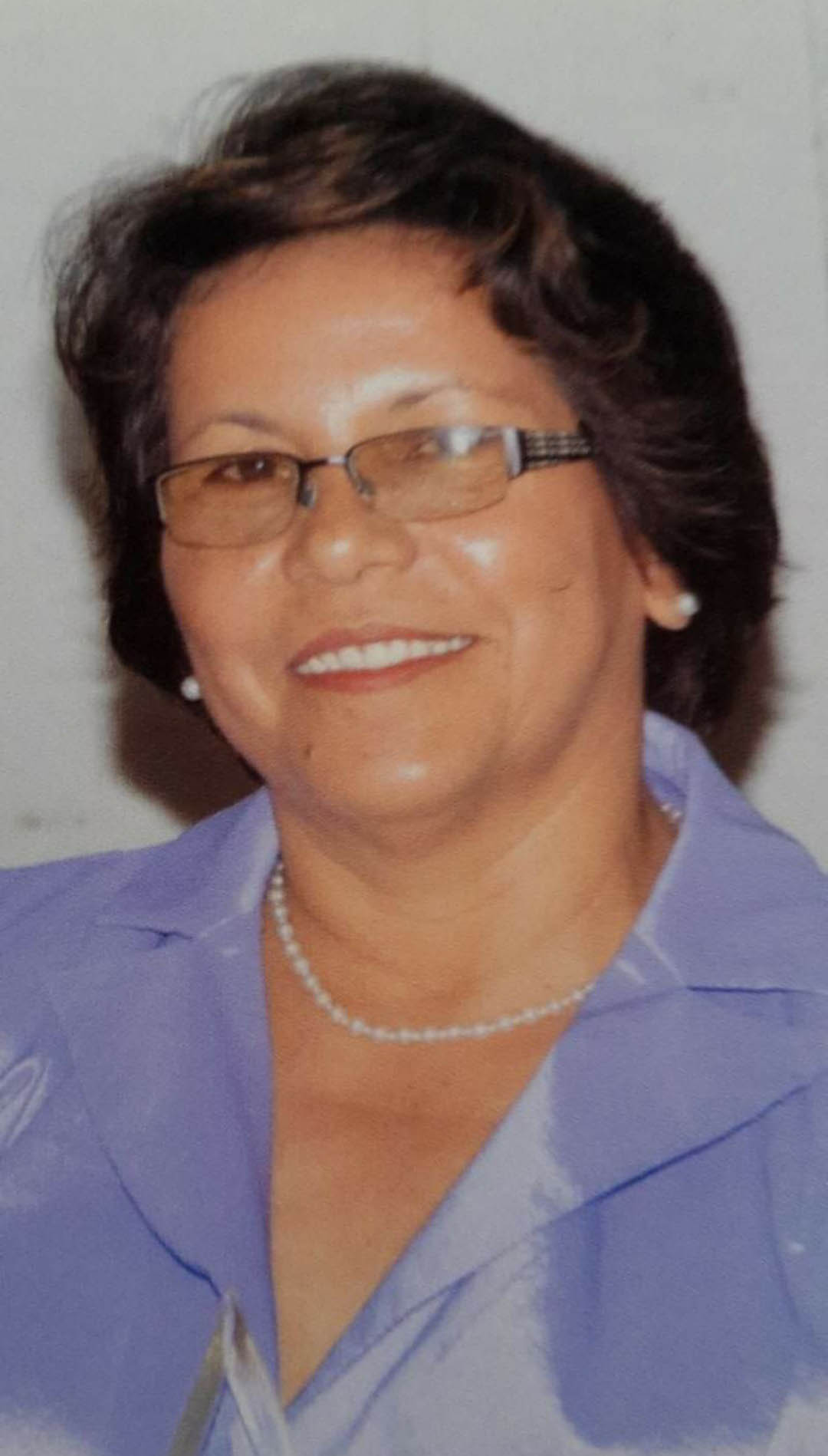Maybe it was swimming morning, noon and afternoon at Acquero Landing, in Region One, or running the dam linking Huradiah with Acquero alongside siblings and cousins, or dashing across the savannahs during the dry season and then swimming the Moruca River to get to Cabucalli.
They were all experiences that in some way led to Stephanie Gomes-Fraser being recognized as one of Guyana’s leading sports personalities, having been a former karateka, judoka, life guard instructor, swim instructor and swim coach.
Gomes-Fraser, 65, a FINA (Federation internationale de natation) referee and retired swim coach, was born at Acquero and was a past student of the then Santa Rosa Roman Catholic School.

“We were encouraged to be rounded students. Swimming was second nature to us. Everybody had to learn to swim to survive in the rivers and creeks, which were literally water streets in the community. I remember the nun, Sister Peter Joseph, who taught us baseball and volleyball. My first competitive sport was running.”
When she took part in one of the inter-school championships representing the North West District, she had met Rocky McPherson of the then National Sports Development Council and when she moved to Georgetown to live during her early teen years she joined an athletic club on his advice. However, one day while running in the National Park she stepped in a crack on the track, fell and injured her knee. Swimming therapy was recommended and she joined Blue Dolphin Swim Club that was being run at then Luckhoo Swimming Pool by the late Vibert Charles and Edwin Bispat.
“Coming out of Moruca I knew to swim but I was not familiar with the techniques in the pool. Within a week or two, I was into the techniques and on par with other swimmers, so much so that when some Canadian instructors came and conducted training sessions for instructors, I passed. I started working with Charles and Bispat. I was about 17 years old and my first pay was $17. I was so excited I took my friend for snacks and drinks and still had change.” While swimming and running, she attended Ms Singh’s Commercial School on East Street.

But Gomes-Fraser had to find a proper job. Her grandmother, Josephine Robinson, with whom she spent her early childhood, had wanted her to become a nurse and with the assistance of the nuns from Santa Rosa she was trained as a nurse aide at St Joseph Mercy Hospital.
“Nursing wasn’t my calling and so I worked as a nurse aide/receptionist at St Joseph Mercy Hospital for a few years.”
Tribute to Jenny
“From a child at Acquero I was very active. Jenny (Jennifer La Rose-Liu, now deceased) and I used to climb trees and swing on vines from branches like Jane in Tarzan, the movie. When the vines broke, we would end up in the slushy savannah mud, our first mud spa. Now that I am older and wiser, I honestly think, as children, we had guardian angels. I smile when I remember those days.”
According to Gomes-Fraser, she and Jenny ran in inter-house athletic championships competing against each other. We won many events and we were both champion girls.”
On arrival in Georgetown, she was back in contact with her friend, Jenny from Acquero, who was doing karate with Sensei Frank Woon-a-Tai. With Jenny’s encouragement, she joined the karate fraternity. Jenny and Gomes-Fraser along with Maureen Woon-a-Tai were among Guyana’s first female karatekas. “I am proud to say I was in the first batch of students who did karate on the lawns of the Anglican Archbishop’s residence in Kingston.”
At 17 years, Jenny would tow Gomes-Fraser to karate training. “One day, Jenny said. ‘This is nonsense. You better learn to ride.’ I jumped on her bike and started learning to ride. Within two weeks I was towing her. We would go to matinees and walked. We used to walk to go shopping or wherever we wanted to go because we were fit. We wanted to try out our skills but no one would attack us.”
During her karate days, she met judoka David Fraser, to whom she would later be married, and started practicing judo. “It was a male-dominated sport. During one competition I had to fight a male and he went into a shoulder throw, slipped and fell on top of me and broke my clavicle. I should have been out for about six months but after four months I went back and broke the clavicle again in the same spot. That kept me out for almost a year. I then became a judo instructor.”
Return to swimming
Gomes-Fraser got married in 1979 and the union produced a daughter, Dee-Anne, and son, Nicholas. “My marriage lasted for ten years. During my marriage I took a break from all sports but my children were attending Stella Maris. We would walk every day from Section M, Campbellville to Woolford Avenue. After dropping them off, I would walk to St Joseph Mercy Hospital, where I worked.”
When Dee-Anne was writing the then Secondary Schools Entrance Examinations, Gomes-Fraser realized her daughter was stressed out from studying and needed an extra-curricular activity. She joined up for family membership swimming courses at Hotel Tower and began taking her children there for swimming lessons, teaching them herself.
It was no surprise that her children became national swimmers. Nicholas held a back stroke record for many years. Today he is the holder of a bachelor’s degree in physical education and a master’s degree in sports management. “Maybe I was influential in guiding his career path.” Her multitalented granddaughter, who plays the violin and guitar and is also into the Shotokan martial arts, is now a purple belt holder and competing for her club.
At Hotel Tower when then swimming instructor Neil Goberdhan, an amputee, could not demonstrate one of the techniques, Gomes-Fraser assisted him. When Goberdhan migrated, Gomes-Fraser took over swimming instructions in the evenings at Hotel Tower.
“That was how my involvement in the learn-to-swim coaching programme came about. I became the in-house swimming instructor at Tower and from there word got around. Pegasus Hotel and the Russian Embassy also contacted me. I even had a stint with the Guyana Bank for Trade and Industry pool in Bel Air. I had to recruit former swimmers and train them as instructors. I couldn’t do it alone. The work load was so great and lucrative I gave up my full time job.”
In 1992 when the Peoples Progressive Party won the general elections and Dr Cheddi Jagan announced that he was going to open up Castellani Pool to the public and Mrs Janet Jagan was introduced as a former competitive swimmer at the university where she studied, Gomes-Fraser approached the government for pool time.
“That was how Dorado Speed Swim Club was formed. After I got through with club time, the Guyana Amateur Swimming Association (GASA), which had been dormant for a while, was resuscitated in 1993. Dorado played a major role in its resuscitation. Eventually GASA was re-affiliated to FINA.
Trinidad and Tobago swim coach Maurice Faria encouraged Gomes-Fraser and other local coaches to become affiliated with the American Swimming Coaches Association (ASCA) and become trained coaches.
Over the years, she said, coaching at the club and national levels became time consuming as they were not paid jobs. “A swimming instructor makes more money than a coach. I was the only senior female coach before another female came on board. It was a struggle.”
As a coach she tried to learn everything relating to the sport. “I became a massage specialist because we could not afford to walk with physiotherapists to competitions. I also did courses in nutrition and I was an anti-doping chaperone in Guyana.”
While she was coaching, Gomes-Fraser joined with a friend who was a designer and tailor to start sewing.
Sewing served swimming in good stead. “When we first started competing regionally and internationally, we could not get competition swimsuits locally. I sourced spandex material from Trinidad to make swim wear for our swimmers. I was sewing and coaching at club level when around 1998/1999, then Minister of Culture, Youth and Sport (MCYS), Gail Teixeira asked me to design a programme for the use of Colgrain swim pool which had been acquired from Booker Tate.”
She was appointed on a contract basis to work as an administrator with the MCYS. “I started the learn-to-swim programme at Colgrain. We had programmes for everyone including persons with disabilities. I taught a number of physiotherapists who were into hydrotherapy to swim. We helped them with water exercises. Some new clubs were formed and time was allotted to them so that Colgrain was busy from 5.00 am to 9.00 pm.”
With Colgrain and Castellani pools being available to the public, Colgrain was used as the nursery and Castellani for competitive swimming. With improvements in swimming, the lobby for a 50-metre Olympic size pool began. The 50-metre pool at Liliendaal came into being during her term as a sports administrator with MCYS.
She recalled during a Goodwill Swim Championship training session in Suriname a Guyanese swimmer looking up and shouting out midway at the Zwenbad Parima Swimming Pool: “This pool ain’t got no end?”
At the MCYS, she also assisted in organizing annual triathlons in the three counties, and every year she has assisted in the running of the annual National Track and Field, Cycling and Swimming Championships hosted by the Guyana Teachers’ Union.
Since 2018 she has coached the swimmers in the Guyana Defence Force (GDF) who compete in the Joint Services sporting championships. The GDF is a member of the world military games.
Challenges
Three of her club swimmers, Niall Roberts, Britany Van Lange and Hannibal Gaskin, are Olympians and she has had several who made it to the World Swim Championships.
“This is because Dorado is one of the more organised clubs. Because I am a woman I really had to fight to stay to be a cut above the rest. Some of the criticisms and nasty comments levelled at me helped me because I was determined to show my male counterparts that they could not pull me down. My reward is when my swimmers performed well and if I had to do it over again, I [would].”
At present, she said, it is somewhat discouraging to see the majority of clubs focusing on sprints. “Not everyone is a sprinter. We have to cater for middle distance and long distance swimmers.
That is very unfortunate.”
With all the hard work put into resuscitating GASA, she said, “it is really disappointing to see selection criteria that were fair and transparent for coaches and swimmers attending meets being ignored and disregarded. Coaches who are not familiar with elite swimmers have been allowed to accompany them and a junior coach was allowed to accompany an elite swimmer to an international meet because of favours.”
She added, “That started in 2012 and that was how corruption started in GASA. It continues to happen, even with selection of swimmers as we saw happening in the last Olympics. At present, our club is trying to bring it to light but it is not being taken nicely. GASA has six clubs and one coach, coaches four to five of these clubs. It upsets me to see quid pro quo taking place blatantly.”
Gomes-Fraser and swimming instructor/coach Ewin Enmore have also been trained as lifeguard instructors with the Canadian Life Saving Society. They have trained about 20 lifeguards and the objective was that resorts would have employed some of them to overlook their water parks. “It never took off. I don’t know the reason.”
For her dedication to sports, Gomes-Fraser was named the 2009 and 2012 Female Sports Personality by the National Sports Commission and in 2011 she was awarded a medal of service by the Guyana Government. In 2009 she was given an award for her efforts towards the advancement of swimming. The Ministry of Indigenous Peoples Affairs also honoured her for her years in promoting swimming. The Guyana Olympic Association also gave her an award for the development of sports in general in Guyana.

